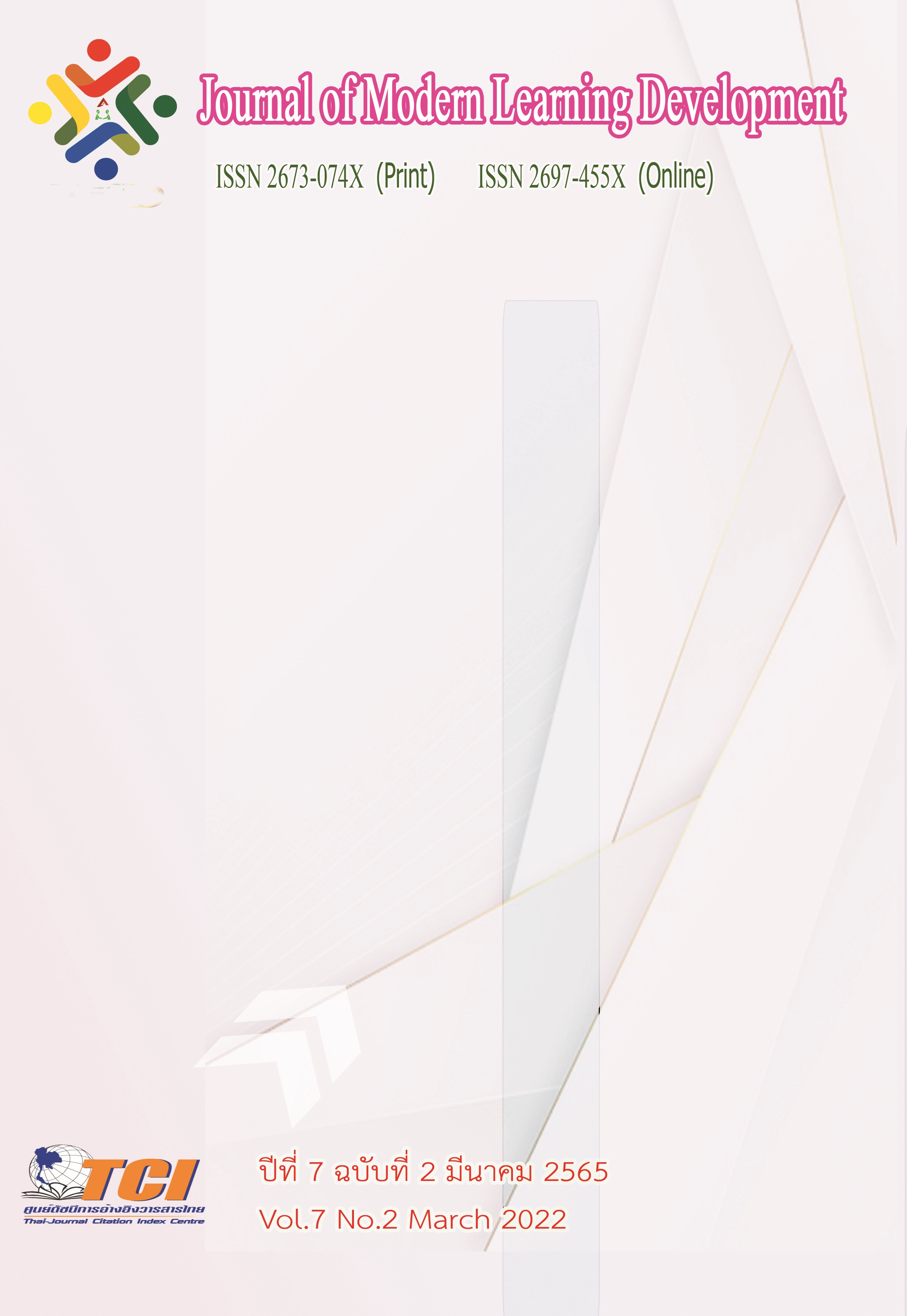The Effects of Cooperative Learning Techniques on Thai Secondary School Students’ Reading Comprehension
Main Article Content
Abstract
This study examined the effect of cooperative learning on reading comprehension and sought to explore participants’ attitudes toward the CL method. Ninety Thai EFL secondary students were divided into the control group (n=30) and the experimental group (n=60). Their age ranged between 13 and 14 years old. They had studied English for more than seven years, and none of them had studied English in an English-speaking country. Three research instruments were employed to collect the data: a reading comprehension test, a questionnaire, and a semi-structured interview.
The quantitative data were analyzed using t-test, standard deviation, mean, and percentage. The results showed that the CL method could lead to gains in reading comprehension among Thai secondary school students. Participants in the group control scored 10.76 at T1 and 10.90 at T2. However, it must be noted that, in the current study, the CL and control groups had significantly different levels of reading comprehension before the investigation, which limits the conclusions of this study. And the overall means of the self-ratings from the attitude questionnaire was 3.45. Nevertheless, the qualitative findings supported the benefits of the CL method and the positive attitudes toward the CL approach. Overall, the current results support the benefits of cooperative learning on reading comprehension, and CL also developed secondary students' attitudes toward reading comprehension.
Article Details
References
Alvermann, D., & Earle, J. (2003). Comprehension instruction. Rethinking reading comprehension, 12-30.
Brunstein, J. C., & Kieschke, U. (2009). Improving students' reading comprehension skills: Effects of strategy instruction and reciprocal teaching. Learning and Instruction,
(3), 272–286.
Department of Curriculum and Instruction Development. (2010). Benefits of Cooperative learning approach. Online. Retrived April 30, 2021, from http://academic.obec. go.th/images/ document/1525235513_d_1.pdf
Felder, R. M., & Brent, R. (2007). Cooperative learning. Active learning: Models from the analytical sciences, 970, 34-53.
Lavasani, M. G., Afzali, L., Borhanzadeh, S., Afzali, F., & Davoodi, M. (2011). The effect of
cooperative learning on the social skills of first grade elementary school girls. Procedia-Social and Behavioral Sciences. 15, 1802-1805.
Liao, (2014). Jigsaw-based cooperative learning approach to improve learning outcomes for mobile situated learning. Journal of Educational Technology & Society. 17 (1), 128-140.
Garcia, E. E. (1989). “Hispanic” children: Theoretical, empirical, and related policy issues. Educational Psychology Review. 4 (1), 69-93.
Ghaith, G., & El-Malak, M. A. (2004). Effect of Jigsaw II on literal and higher order EFLreading comprehension. Educational Research and Evaluation, 10(2), 105-115.
Gillies, R. M., & Ashman, A. F. (2000). The effects of cooperative learning on students with
learning difficulties in the lower elementary school. The Journal of Special Education, 34 (1), 19-27.
Gollnick, D. M., Chinn, P. C., Kroeger, S. D., & Bauer, A. M. (2009). Multicultural education in a pluralistic society (Vol. 90). Columbus, OH: Merrill.
Jalilifar, A. (2010). The effect of cooperative learning techniques on college students’ reading
comprehension. System, 38 (1), 96-108.
Jatupan, K. & Sanukul, K. (2017). A study of cooperative learning classroom in health system subject among of pharmacy technique students at Sirindhorn College of Public Health Khonkaen. Thailand. The 8th Hatyai National and International Conference. (pp. 524-533) Hatyai, Thailand: Hatyai University.
Johnson, D. W., & Johnson, R. (1998). Active Learning: Cooperation in the College Classroom (2nd Edition). Edina, MN: Interaction Book Company.
Johnson, R. T., & Johnson, D. W. (2008). Active learning: Cooperation in the classroom. The annual report of educational psychology in Japan. 47, 29-30.
Johnson, D. W., & Johnson, R. T. (2014). Using technology to revolutionize cooperative learning: an opinion. Frontiers in psychology, 5, 1156.
Kuuk, Ö., & Arslan, A. (2020). Cooperative Learning in Developing Positive Attitudes and Reflective Thinking Skills of High School Students' in English Course. International
Journal of Psycho-Educational Sciences. 9 (1), 83-96.
Marashi, H., & Dibah, P. (2013). The Comparative Effect of Using Competitive and Cooperative Learning on the Oral Proficiency of Iranian Introvert and Extrovert EFL Learners. Journal of Language Teaching and Research, 4, 545-556.
Marzban, A., & Akbarnejad, A. A. (2013). The effect of cooperative reading strategies on improving reading comprehension of Iranian university students. Procedia-Social and Behavioral Sciences. 70, 936-942.
Murtono, A. (2015). Pemanfaatan Foam Agent dan Material Lokal dalam Pembuatan Bata Ringan (Doctoral dissertation, Universitas Muhammadiyah Surakarta).
Nunnery, J. A., Chappell, S., & Arnold, P. (2013). A meta-analysis of a cooperative learning models effects on student achievement in mathematics. Cypriot Journal of Educational Sciences. 8 (1), 34-48.
Pan, C. Y., & Wu, H. Y. (2013). The Cooperative Learning Effects on English Reading Comprehension and Learning Motivation of EFL Freshmen. English Language Teaching. 6 (5), 13-27.
Priyantin, T. (2014). Students' attitudes towards cooperative learning in enhancing their motivation to speak. In 61st TEFLIN International Conference, Sebelas Maret University, Solo (7-9).
Scaglion, R. (1992). Entropy and convergence in Melanesian studies. Reviews in Anthropology. 21(3), 245-253.
Sihombing, T., & Katemba, C. V. (2019). The Comparison Between START and TAI Models in Improving SMP Students' Reading Comprehension Ability. Acuity: Journal of English Language Pedagogy, Literature and Culture. 4 (1), 32-43.
Slavin, R. E. (1982). Cooperative learning: Student teams. What research says to the teacher.
National Education Association Professional Library, PO Box 509, West Haven, CT
(Stock No. 1055-8-00; $2.00).
Slavin, R. E. (2008). Cooperative learning, success for all, and evidence-based reform in education. Éducation et didactique, (2-2), 149-157.
Tsai, G., Yang, P., Chung, L. C., Lange, N., & Coyle, J. T. (1998). D-serine added to antipsychotics for the treatment of schizophrenia. Biological psychiatry. 44 (11), 1081-1089.
The National Institute of Educational Testing Service (NIETS). (2020). O-NET: Ordinary national educational test 2019. Online. Retrieved fromhttps://www. niets.or.th/th/ content/ view/17797
Thippawan, (2002) Humoral immune responses and human immunodeficiency virus type 1 (HIV-1) evolution during the course of infection in Thai individuals . Mahidol University/Bangkok. DOI : https://doi.nrct.go.th/ListDoi/listDetail?Resolve_DOI=
Wei, (1997). Effective teamwork at the top: the evidence from China. The International Journal of Human Resource Management. 23 (9), 1853-1870.
Yotayut. (2012). การเปรียบเทียบผลการเรียนวิชาวิทยาศาสตร์ระหว่างการสอน โดยใช้ชุดการสอนแบบศูนย์การเรียนที่เน้นกระบวนการเรียนแบบร่วมมือ กับการสอนตามคู่มือครูของ สสวท. ของนักเรียนชั้นมัธยมศึกษาปีที่ 3. วิทยานิพนธ์ ครุศาสตร์มหาบัณฑิตนครราชสีมา. บัณฑิตวิทยาลัย: สถาบันราชภัฏนครราชสีมา.


